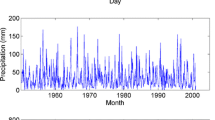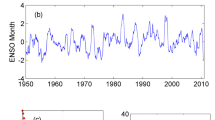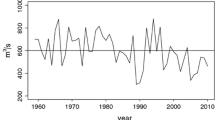Abstract
Recent developments in the identification, estimation and diagnostic checking of deseasonalized autoregressive moving-average (ARMA) models and periodic autoregressive (PAR) models are reviewed. These techniques are then used for fitting PAR and deseasonalized ARMA models to three specific monthly riverflow time series. The Akaike information criterion (AIC) and Bayes information criterion (BIC) suggest the PAR model provides the best fit. Split-sample simulation experiments show that the PAR models preserve the critical drought statistics of the historical flow sequences.
Access this chapter
Tax calculation will be finalised at checkout
Purchases are for personal use only
Preview
Unable to display preview. Download preview PDF.
Similar content being viewed by others
References
Akaike, H. (1974), “A new look at the statistical model identification.” IEEE Transactions on Automatic Control AC-19, 716–723.
Ansley, C. F. (1979), “An algorithm for the exact likelihood of a mixed autoregressive-moving average process.” Biometrika 66, 59–65.
Askew, A. J., W. W. G. Yeh, and W. A. Hall (1974), “A comparative study of critical drought simulation.” Water Resources Research 7, 52–62.
Box, G. E. P., and D. R. Cox (1964), “An analysis of transformations.” Journal of the Royal Statistical Society, Series A 127, 211–252.
Box, G. E. P., and G. Jenkins (1976), Time Series Analysis, Forecasting and Control, 2nd edition. San Francisco: Holden-Day.
Box, G. E. P., and M. E. Muller (1958), “A note on the generation of random normal deviates.” Annals of Mathematical Statistics 29, 610–611.
Clarke, R. T. (1973), “Mathematical models in Hydrology.” Irrigation and Drainage Paper 19, Food and Agricultural Organization of the United Nations, Rome, Italy.
Croley, T. E., and K. N. R. Rao (1977), “A manual for hydrologic time series deseasonalization and serial dependence reduction.” Report 199, Iowa Institute of Hydraulic Research, University of Iowa, Iowa City, Iowa.
Delleur, J. W., P. C. Tao, and M. L. Karvas (1976), “An evaluation of the practicality and the complexity of some rainfall and runoff time series models.” Water Resources Research 12, 953–970.
Fiering, M. B., and B. B. Jackson (1971), “Synthetic streamflows.” Water Resources Monograph 1, American Geophysical Union, Washington, D. C.
Fisher, R. A. (1970), Statistical Methods for Research Workers. Edinburgh, England: Oliver and Boyd.
Hall, W. A., A. J. Askew, and W. W. G. Yeh (1969), “Use of the critical period in reservoir analysis,” Water Resources Research 5, 1205–1215.
Hipel, K. W. (1981), “Geophysical model discrimination using the Akaike information criterion.” IEEE Transactions on Automatic Control AC-26, 358–378.
Hipel, K. W., and A. I. McLeod (1978), “Preservation of the rescaled adjusted range, part two, simulation studies using Box-Jenkins models.” Water Resources Research 14, 509–516.
Hipel, K. W., and A. I. McLeod (1979), “Modelling seasonal geophysical time series using deseasonalized models.” Technical Report XM-030579, Department of Systems Design Engineering, University of Waterloo, Waterloo, Ontario.
Hipel, K. W., and A. I. McLeod (1986), Time Series Modelling for Water Resources and Environmental Engineers. Amsterdam: Elsevier. In press.
Hipel, K. W., A. I. McLeod, and W. C. Lennox (1977), “Advances in Box-Jenkins modelling, 1, model construction.” Water Resources Research 13, 567–575.
Lawrance, A. J., and N. T. Kottegoda (1977), “Stochastic modelling of riverflow time series.” Journal of the Royal Statistical Society, Series A 140, 1–47.
Ledolter, J., and B. Abraham (1981), “Parsimony and its importance in time series forecasting.” Technometrics 23, 411–414.
Ljung, G. M., and G. E. P. Box (1979), “The likelihood function of stationary autoregressive-moving average models.” Biometrika 66, 265–270.
McClave, J. T. (1975), “Subset autoregression.” Technometrics 17, 213–220.
McLeod, A. I. (1977), “Improved Box-Jenkins estimators.” Biometrika 64, 531–534.
McLeod, A. I. (1978), “On the distribution of residual autocorrelations in Box-Jenkins models.” Journal of the Royal Statistical Society, Series B 40, 296–302.
McLeod, A. I., and K. W. Hipel (1978a), “Developments in monthly autoregressive modelling.” Technical Report 45-XM-011178, Department of Systems Design Engineering, University of Waterloo, Waterloo, Ontario.
McLeod, A. I., and K. W. Hipel (1978b), “Preservation of the rescaled adjusted range, part one, a reassessment of the Hurst phenomenon.” Water Resources Research 14, 491–508.
McLeod, A. I., and K. W. Hipel (1978c), “Simulation procedures for Box-Jenkins models.” Water Resources Research 14, 969–975.
McLeod, A. I., K. W. Hipel, and W. C. Lennox (1977), “Advances in Box-Jenkins modelling, 2, applications.” Water Resources Research 13, 577–586.
McLeod, A. I., and W. K. Li (1983), “Diagnostic checking ARMA time series models using squared-residual autocorrelations.” Journal of Time Series Analysis 4, 269–273.
McMahon, T. A., and R. G. Mein (1978), Reservoir Capacity and Yield. Amsterdam: Elsevier.
Moss, M. E., and M. C. Bryson (1974), “Autocorrelation structure of monthly steamfiows.” Water Resources Research 10, 737–744.
Noakes, D. J., A. I. McLeod, and K. W. Hipel (1983), “Forecasting experiments with seasonal hydrological time series models.” Technical Report 117-XM-220283, Department of Systems Design Engineering, University of Waterloo, Waterloo, Ontario.
Noakes, D. J., A. I. McLeod, and K. W. Hipel (1985), “Forecasting monthly riverflow time series.” International Journal of Forecasting 1, 179–190.
Pagano, M. (1978), “On periodic and multiple autoregression.” Annals of Statistics 6, 1310–1317.
Parzen, E., and M. Pagano (1979), “An approach to modelling seasonally stationary time series.” Journal of Econometrics 9, 137–153.
Rao, A. R., and R. L. Kashyap (1974), “Stochastic modelling of river flows.” IEEE Transactions on Automatic Control AC-19, 874–881.
Sakai, H. (1982), “Circular lattice filtering using Pagano’s method.” IEEE Transactions on Acoustics, Speech and Signal Processing ASSP-30, 279–287.
Salas, J. D., D. C. Boes, and R. A. Smith (1982), “Estimation of ARMA models with seasonal parameters.” Water Resources Research 18, 1006–1010.
Salas, J. D., J. W. Delleur, V. Yevjevich, and W. L. Lane (1980), Applied Modelling of Hydrologic Time Series. Littleton, Colorado: Water Resources Publications.
Schwarz, G. (1978), “Estimating the dimension of a model.” Annals of Statistics 6, 461–464.
Sen, Z. (1978), “A mathematical model of monthly flow sequences.” Hydrological Sciences Bulletin 23, 223–229.
Tao, P. C., and J. W. Delleur (1976), “Seasonal and nonseasonal ARMA models in hydrology.” Journal of the Hydraulics Division, ASCE 102, 1541–1559.
Thompstone, R. M. (1983), “Topics in hydrological time series modelling.” Ph.D. Thesis, Department of Systems Design Engineering, University of Waterloo, Waterloo, Ontario.
Thompstone, R. M., K. W. Hipel, and A. I. McLeod (1985a), “Forecasting quarter-monthly riverflow.” Water Resources Bulletin 21, 731–741.
Thompstone, R. M., K. W. Hipel, and A. I. McLeod (1985b), “Grouping of periodic autoregressive models.” In Time Series Analysis—Theory and Practice 6, ed. 0. D. Anderson, J. K. Ord and E. A. Robinson, pp. 35–49. Amsterdam: Elsevier Science.
Thompstone, R. M., A. Poké, and A. Vallée (1980), “A hydrometeorological information system for water resources management.” INFOR-Canadian Journal of Operational Research and Information Processing 18, 258–274.
Troutman, B. M. (1979), “Some results in periodic autoregression.” Biometrika 66, 219–228.
Vecchia, A. V. (1985), “Periodic autoregressive-moving average (PARMA) modelling with applications to water resources.” Water Resources Bulletin 21, 721–730.
Wichmann, B. A., and I. E. Hill (1982), “An efficient and portable pseudo-random number generator.” Journal of the Royal Statistical Society, Series C 31, 188–190.
Yevjevich, V. M. (1972), “Structural analysis of hydrologic time series.” Hydrology Paper 56, Colorado State University, Fort Collins, Colorado.
Author information
Authors and Affiliations
Editor information
Editors and Affiliations
Rights and permissions
Copyright information
© 1987 D. Reidel Publishing Company, Dordrecht, Holland
About this chapter
Cite this chapter
Thompstone, R.M., Hipel, K.W., McLeod, A.I. (1987). Simulation of Monthly Hydrological Time Series. In: MacNeill, I.B., Umphrey, G.J., McLeod, A.I. (eds) Advances in the Statistical Sciences: Stochastic Hydrology. The University of Western Ontario Series in Philosophy of Science, vol 37. Springer, Dordrecht. https://doi.org/10.1007/978-94-009-4792-4_4
Download citation
DOI: https://doi.org/10.1007/978-94-009-4792-4_4
Publisher Name: Springer, Dordrecht
Print ISBN: 978-94-010-8625-7
Online ISBN: 978-94-009-4792-4
eBook Packages: Springer Book Archive




